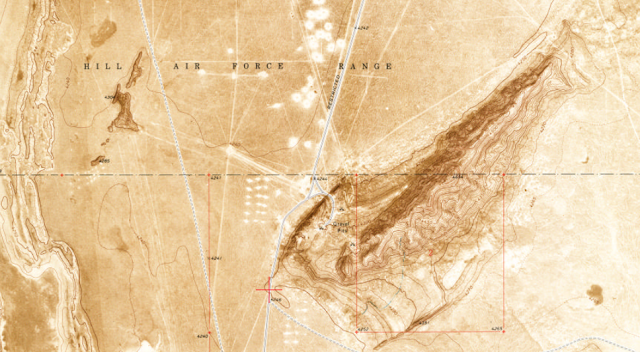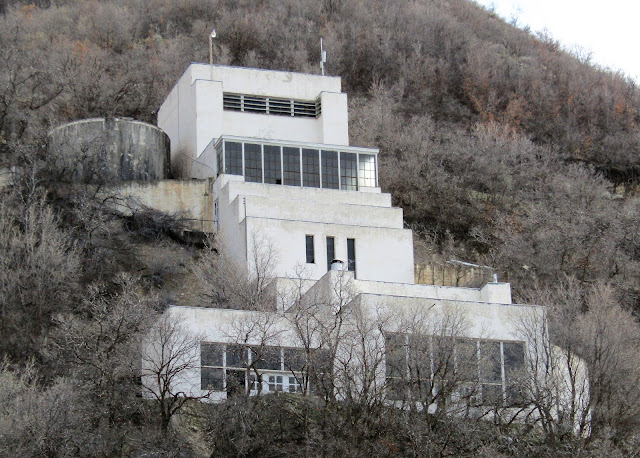At the turn of the 20th Century, mining was big business in
Utah. From 1865 to 1915, the three largest mining districts in the
state produced over three-quarters of a billion dollars of precious metals. The mines had a
problem, though. The deeper they got, the more difficult and expensive the
work. Corporate interests took over mines and started using heavy, steam-driven
equipment to excavate. The fuel needed to run the equipment was a significant expense, so following the lead of mines in Colorado, mines in Utah looked
at ways to provide electricity for their machinery.
 |
| The mining town of Mercur around the turn of the 20th Century. |
This need for electricity led to an explosion in the
construction of small, run-of-the-river hydroelectric plants. These plants,
which diverted water from rivers to spin turbines, generating electricity
before the water returned to the river, were built on many streams along the
Wasatch Front. Still-standing examples of these plants can be seen at Olmsted, at the mouth of
Provo Canyon, and the Stairs Hydroelectric Plant in Big Cottonwood Canyon.
 |
| Electrical heavy equipment operating at the Apex mine in Bingham. |
Allan Lamson, the president of a mining company involved in
the Bingham area and a business promoter in Salt Lake City, identified the Jordan Narrows area at the south end of the
Salt Lake Valley as having the potential to provide power for Bingham and
Mercur. He organized what eventually became the Salt Lake City Water & Electrical Power Company, with himself as president. The company purchased land in what is
now Bluffdale in 1897 and began construction the next year.
 |
| The Jordan Narrows Plant in 1909. This photo was part of a system inventory by Telluride Power. |
Aside from the expense and difficulty of building and
outfitting the new power plant, Lamson also faced challenges in procuring water
the operate the plant. In his efforts to supply his plant, Lamson set off a
water war that bankrupted his company and settled water rights in the Jordan
River for good (aside from a bunch of appeals).
The water from the Jordan River and Utah Lake had long been
claimed by Salt Lake City and four large canal companies, which each claimed a
one sixth share of the river with the last sixth passing down the river. The
new company wanted to take essentially all of the water in the river, pass it
through the power plant, and then return it to the canals or to the river.
Lamson came to an agreement with one the canals, the Utah and Salt Lake Canal,
in exchange for taking over their share of maintenance of the diversion dam and
part of their canal. Salt Lake City and the other companies were less willing
to make a deal, fearing that it could damage their claim to ownership of the
water as they were only using half of their claimed water at that time.
 |
| The interior of the Jordan Narrows plant, showing their turbines and generators. |
When the City declined to partner with him, Lamson secretly
filed for ownership of all of the water the City and canal companies claimed
but were not using. He also simply began diverting as much water as he wanted
to his power plant, which began operating on January 15, 1899. The City and
canal companies filed a lawsuit to determine actual ownership of the water.
While the case was pending, the City shifted its diversion of the river above
the power plant so that it could not be taken. However, Lamson's men struck back
by cutting the City's canal and diverting the water back to the power plant.
In March 1900, Lamson was forced to step down and Alexander
Tarbet, the other major owner and a major mining figure, took over management
of the company. By April, the lack of water was forcing shutdowns of the plant,
angering their customers in the mining camps. Although the plant resumed
operations soon thereafter, the company continued to struggle financially and
entered receivership in July 1900. The water rights situation was finally
resolved in 1901 when Judge Morse made final determination of ownership and
allowed the company to use any water in the river above their power plant. This decision is now called the Morse Decree and is the basis for all water rights in the Jordan River and Utah Lake.
 |
| Miners in the electrified Golden Gate mine. |
Despite this victory and despite strong demand from the mining camps, the Jordan Narrows plant struggled with water availability and high levels of debt (they owed nearly half a million dollars to Lamson and Tarbet as well as to equipment suppliers). Several years of drought led to the installation of pumps at Utah Lake to
push more water into the river, powered by the Jordan Narrows plant. However,
this had the unfortunate effect in low water years that, if the pumps were
stopped for any reason, the power plant would also stop operating and neither
the plant nor the pumps could be restarted until water levels rose again.
Despite resolving its water rights issues, the company
continued to struggle in receivership to pay its debts. It was ordered sold in
1903, but struggled to find anyone willing to pay even a reduced price.
Although the company, with its primary asset the Jordan Narrows plant, was originally listed for $65,000, it was eventually sold in
the summer of 1904 to W.S. McCornick, another prominent Salt Lake City
businessman, for $37,500. It was sold again to the Telluride Power Company,
owned by Lucien Nunn, in January 1906 for less than $17,000.
 |
| Another photo of the Narrows plant in 1913, another Telluride system inventory. |
 |
| A sketch of the plant's penstocks, which carried water to the turbine. From the Salt Lake Mining Review in 1909. |
The Telluride Power Company, including the Jordan Narrows
Plant was sold to the new Utah Power and Light Company, the predecessor of
Rocky Mountain Power, in 1913. The plant is thought to have operated into the
early 1920s, closing between 1921 and 1924. Rocky Mountain Power continues to own the land today.
Today, the ruins of the Jordan Narrows plant are visible
adjacent to the Jordan River Parkway Trail, near Iron Horse Boulevard. Although
the building has been removed, visitors can see the remains of the concrete
forebay (a small reservoir where water was slowed before it ran into the
turbines), the foundation of the plant's substation, the canal that carried water to the plant, and the foundations of
the plant itself.
If you go to see the plant, please keep in mind that it is located on private property. Respect the site as an important archaeological and historical site and stay on the trail.
 |
| The forebay, with the spillway in the foreground. |
 |
| Looking into the forebay from the spillway. |
 |
| The spillway again, with the Jordan River Parkway Trail about where the big concrete pipe is. |
 |
| The canal to carry water to the plant. They shored up bends in the canal with concrete walls. |
 |
| What's left of one of the two penstocks. |
 |
| I think this is probably the rear wall of the former plant. |
 |
| The foundation of the substation building. |
















Comments
Post a Comment